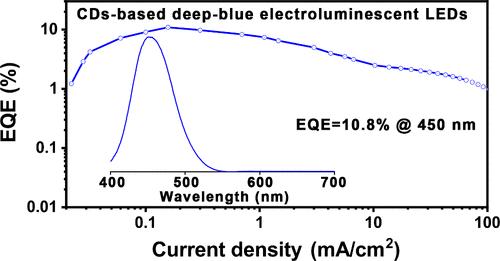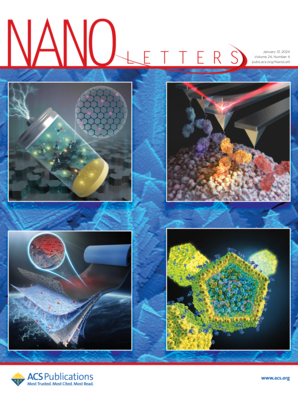Solution-Processed Near Unit Carbon Dots-Based Deep-Blue Electroluminescent Light-Emitting Diodes with External Quantum Efficiency over 10%
IF 9.1
1区 材料科学
Q1 CHEMISTRY, MULTIDISCIPLINARY
引用次数: 0
Abstract
Deep-blue electroluminescent light-emitting diodes (ELEDs) are crucial for various applications, including solid-state lighting, high-density information storage, and vibrant displays. Currently, the development of conventional deep-blue ELEDs is predominantly based on multilayer evaporation structures. Despite significant technological progress, the fabrication of electroluminescent devices via low-cost solution processing has still not fully been realized. Given that, a novel approach for their development based on deep-blue emission carbon dots (CDs) has been proposed in this study. The as-prepared CDs exhibited a quantum yield close to 100% and a high exciton binding energy. The CDs-based ELEDs provided deep-blue emission at a wavelength of 450 nm, with CIE coordinates of (0.15, 0.07), closely approaching the standard color of the Rec. 2020 specification (0.131, 0.046). These results provide sufficient evidence that the devices fabricated in this work are one of the highest-performing CDs-based ELEDs developed so far, providing a quantum efficiency of over 10%.

外量子效率超过10%的溶液处理近单位碳点深蓝电致发光二极管
深蓝电致发光二极管(led)对于各种应用至关重要,包括固态照明,高密度信息存储和充满活力的显示。目前,传统的深蓝发光二极管的发展主要是基于多层蒸发结构。尽管取得了重大的技术进步,但通过低成本溶液加工制造电致发光器件仍未完全实现。鉴于此,本研究提出了一种基于深蓝色排放碳点(CDs)的新型开发方法。所制备的CDs具有接近100%的量子产率和较高的激子结合能。基于cds的led在450 nm波长处提供深蓝色发射,CIE坐标为(0.15,0.07),非常接近Rec. 2020规范的标准颜色(0.131,0.046)。这些结果提供了充分的证据,证明在这项工作中制造的器件是迄今为止开发的性能最高的基于cd的led之一,提供超过10%的量子效率。
本文章由计算机程序翻译,如有差异,请以英文原文为准。
求助全文
约1分钟内获得全文
求助全文
来源期刊

Nano Letters
工程技术-材料科学:综合
CiteScore
16.80
自引率
2.80%
发文量
1182
审稿时长
1.4 months
期刊介绍:
Nano Letters serves as a dynamic platform for promptly disseminating original results in fundamental, applied, and emerging research across all facets of nanoscience and nanotechnology. A pivotal criterion for inclusion within Nano Letters is the convergence of at least two different areas or disciplines, ensuring a rich interdisciplinary scope. The journal is dedicated to fostering exploration in diverse areas, including:
- Experimental and theoretical findings on physical, chemical, and biological phenomena at the nanoscale
- Synthesis, characterization, and processing of organic, inorganic, polymer, and hybrid nanomaterials through physical, chemical, and biological methodologies
- Modeling and simulation of synthetic, assembly, and interaction processes
- Realization of integrated nanostructures and nano-engineered devices exhibiting advanced performance
- Applications of nanoscale materials in living and environmental systems
Nano Letters is committed to advancing and showcasing groundbreaking research that intersects various domains, fostering innovation and collaboration in the ever-evolving field of nanoscience and nanotechnology.
 求助内容:
求助内容: 应助结果提醒方式:
应助结果提醒方式:


